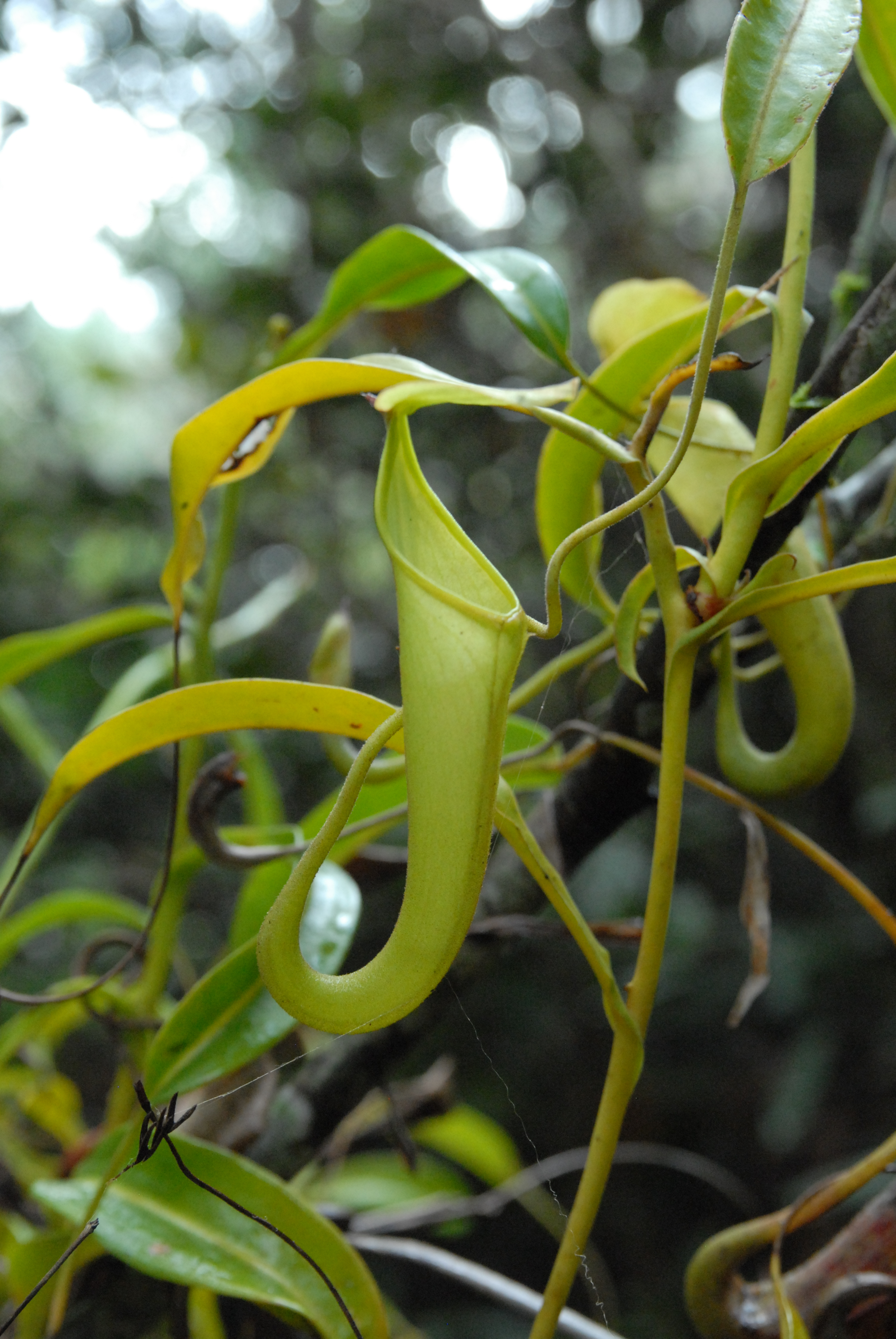|
Nepenthes Paniculata
''Nepenthes paniculata'' (; from Latin ''panicula'' " panicle") is a tropical pitcher plant belonging to the genus '' Nepenthes''. ''Nepenthes paniculata'' is probably endemic to Doorman Top, a mountain in New Guinea (). In recent times it has been recorded from mossy forest on a ridge top at 1,460 m altitude.McPherson, S.R. 2009. ''Pitcher Plants of the Old World''. 2 volumes. Redfern Natural History Productions, Poole. No forms or varieties of this species have been described. It may form natural hybrids with '' N. papuana''. In 1994, A. Wistuba, H. Rischer, B. Baumgartl, and B. Kistler explored Doorman Top in search of ''N. paniculata'' but found no ''Nepenthes'' other than '' N. lamii'' (then known as '' N. vieillardii'') and '' N. maxima''.Wistuba, A. 1994Re: ''Nepenthes''-discussion Carnivorous Plant Mailing List, September 15, 1994. However, they climbed a different slope to the one from which ''N. paniculata'' was originally collected. In ... [...More Info...] [...Related Items...] OR: [Wikipedia] [Google] [Baidu] |
The Nepenthaceae Of The Netherlands Indies
"The Nepenthaceae of the Netherlands Indies" is a seminal monograph by B. H. Danser on the tropical pitcher plants of the Dutch East Indies and surrounding regions. It was originally published in the ''Bulletin du Jardin Botanique de Buitenzorg'' in 1928, and reprinted by Natural History Publications (Borneo) in 2006.Danser, B.H. 2006. ''The Nepenthaceae of the Netherlands Indies''. Natural History Publications (Borneo), Kota Kinabalu. Content Danser focused on species native to the Dutch East Indies, North Borneo, the Malay Peninsula, and eastern New Guinea (an area roughly corresponding to Malesia minus the Philippines); species from outlying areas were only mentioned in the general discussion. Danser recognised 65 species in total, of which 52 were given detailed treatments. This number included 17 newly described taxa: '' N. carunculata'' (later synonymised with '' N. bongso''),Clarke, C.M. 2001. '' Nepenthes of Sumatra and Peninsular Malaysia''. Natural His ... [...More Info...] [...Related Items...] OR: [Wikipedia] [Google] [Baidu] |
Andreas Wistuba
Andreas Wistuba (born 4 March 1967) is a German taxonomist and botanist specialising in the carnivorous plant genera ''Heliamphora'' and '' Nepenthes''. More than half of all known ''Heliamphora'' species have been described by Wistuba. Publications * Nerz, J. & A. Wistuba 1994Five new taxa of ''Nepenthes'' (Nepenthaceae) from North and West Sumatra ''Carnivorous Plant Newsletter'' 23(4): 101–114. * Wistuba, A. & H. Rischer 1996''Nepenthes lavicola'', a new species of Nepenthaceae from the Aceh Province in the North of Sumatra ''Carnivorous Plant Newsletter'' 25(4): 106–111. * Nerz, J. & A. Wistuba 2000''Heliamphora hispida'' (Sarraceniaceae), a new species from Cerro Neblina, Brazil-Venezuela ''Carnivorous Plant Newsletter'' 29(2): 37–41. * Wistuba, A., P. Harbarth & T. Carow 2001''Heliamphora folliculata'', a new species of ''Heliamphora'' (Sarraceniaceae) from the ‘Los Testigos’ Table Mountains in the South of Venezuela ''Carnivorous Plant Newsletter'' 30(4): 120 ... [...More Info...] [...Related Items...] OR: [Wikipedia] [Google] [Baidu] |
Plants Described In 1928
Plants are predominantly photosynthetic eukaryotes of the kingdom Plantae. Historically, the plant kingdom encompassed all living things that were not animals, and included algae and fungi; however, all current definitions of Plantae exclude the fungi and some algae, as well as the prokaryotes (the archaea and bacteria). By one definition, plants form the clade Viridiplantae (Latin name for "green plants") which is sister of the Glaucophyta, and consists of the green algae and Embryophyta (land plants). The latter includes the flowering plants, conifers and other gymnosperms, ferns and their allies, hornworts, liverworts, and mosses. Most plants are multicellular organisms. Green plants obtain most of their energy from sunlight via photosynthesis by primary chloroplasts that are derived from endosymbiosis with cyanobacteria. Their chloroplasts contain chlorophylls a and b, which gives them their green color. Some plants are parasitic or mycotrophic and have los ... [...More Info...] [...Related Items...] OR: [Wikipedia] [Google] [Baidu] |
Flora Of Western New Guinea
Flora is all the plant life present in a particular region or time, generally the naturally occurring ( indigenous) native plants. Sometimes bacteria and fungi are also referred to as flora, as in the terms ''gut flora'' or ''skin flora''. Etymology The word "flora" comes from the Latin name of Flora, the goddess of plants, flowers, and fertility in Roman mythology. The technical term "flora" is then derived from a metonymy of this goddess at the end of the sixteenth century. It was first used in poetry to denote the natural vegetation of an area, but soon also assumed the meaning of a work cataloguing such vegetation. Moreover, "Flora" was used to refer to the flowers of an artificial garden in the seventeenth century. The distinction between vegetation (the general appearance of a community) and flora (the taxonomic composition of a community) was first made by Jules Thurmann (1849). Prior to this, the two terms were used indiscriminately.Thurmann, J. (1849). ''Essai de Ph ... [...More Info...] [...Related Items...] OR: [Wikipedia] [Google] [Baidu] |
Carnivorous Plants Of Asia
A carnivore , or meat-eater (Latin, ''caro'', genitive ''carnis'', meaning meat or "flesh" and ''vorare'' meaning "to devour"), is an animal or plant whose food and energy requirements derive from animal tissues (mainly muscle, fat and other soft tissues) whether through hunting or scavenging. Nomenclature Mammal order The technical term for mammals in the order Carnivora is ''carnivoran'', and they are so-named because most member species in the group have a carnivorous diet, but the similarity of the name of the order and the name of the diet causes confusion. Many but not all carnivorans are meat eaters; a few, such as the large and small cats (felidae) are ''obligate'' carnivores (see below). Other classes of carnivore are highly variable. The Ursids, for example: While the Arctic polar bear eats meat almost exclusively (more than 90% of its diet is meat), almost all other bear species are omnivorous, and one species, the giant panda, is nearly exclusively herbivorous. ... [...More Info...] [...Related Items...] OR: [Wikipedia] [Google] [Baidu] |
Philippines
The Philippines (; fil, Pilipinas, links=no), officially the Republic of the Philippines ( fil, Republika ng Pilipinas, links=no), * bik, Republika kan Filipinas * ceb, Republika sa Pilipinas * cbk, República de Filipinas * hil, Republika sang Filipinas * ibg, Republika nat Filipinas * ilo, Republika ti Filipinas * ivv, Republika nu Filipinas * pam, Republika ning Filipinas * krj, Republika kang Pilipinas * mdh, Republika nu Pilipinas * mrw, Republika a Pilipinas * pag, Republika na Filipinas * xsb, Republika nin Pilipinas * sgd, Republika nan Pilipinas * tgl, Republika ng Pilipinas * tsg, Republika sin Pilipinas * war, Republika han Pilipinas * yka, Republika si Pilipinas In the recognized optional languages of the Philippines: * es, República de las Filipinas * ar, جمهورية الفلبين, Jumhūriyyat al-Filibbīn is an archipelagic country in Southeast Asia. It is situated in the western Pacific Ocean and consists of around 7,641 islands t ... [...More Info...] [...Related Items...] OR: [Wikipedia] [Google] [Baidu] |
Nepenthes Merrilliana
''Nepenthes merrilliana'' (; after Elmer Drew Merrill) is a tropical pitcher plant endemic to the Philippines. It produces some of the largest pitchers in the genus, rivalling those of '' N. rajah''.McPherson, S.R. 2009. ''Pitcher Plants of the Old World''. 2 volumes. Redfern Natural History Productions, Poole. The species is native to northern and central Mindanao as well as neighbouring Dinagat and Samar.Robinson, A. 2012''Nepenthes merrilliana'' on Samar Carnivorous Plants in the tropics, June 29, 2012. Its presence in southern Mindanao is uncertain. It inhabits coastal forest areas on steep slopes at elevations of 0–1100 m above sea level.McPherson, S.R. & V.B. Amoroso 2011. ''Field Guide to the Pitcher Plants of the Philippines''. Redfern Natural History Productions, Poole. '' Nepenthes surigaoensis'' is closely related to ''N. merrilliana'' and was for a long time considered a heterotypic synonym of this species.Danser, B.H. 1928. The Nepenthaceae of the Neth ... [...More Info...] [...Related Items...] OR: [Wikipedia] [Google] [Baidu] |
Das Taublatt
''Das Taublatt'' is a triannual German-language periodical based in Bochum and the official publication of Gesellschaft für fleischfressende Pflanzen im deutschsprachigen Raum, a carnivorous plant society based in Germany.Rice, B. 2010Carnivorous Plant Society Archives The Carnivorous Plant FAQ. rchived page from October 10, 2010/ref>''Das Taublatt'' . Gesellschaft für fleischfressende Pflanzen. Typical articles include matters of horticultural interest, field reports, and new descriptions. The journal was established in 1984. [...More Info...] [...Related Items...] OR: [Wikipedia] [Google] [Baidu] |
Joachim Nerz
Dr. Joachim Nerz (born 1964) is a German taxonomist and botanist specialising in the carnivorous plant genera ''Heliamphora'' and '' Nepenthes''. Nerz has described several new species, mostly with Andreas Wistuba. Publications * Schlauer, J. & J. Nerz 1994. Notes on ''Nepenthes'' (Nepenthaceae). I. Contributions to the Flora of Sumatra. ''Blumea'' 39: 139–142. * Nerz, J. & A. Wistuba 1994Five new taxa of ''Nepenthes'' (Nepenthaceae) from North and West Sumatra ''Carnivorous Plant Newsletter'' 23(4): 101–114. * Nerz, J., P. Mann, T. Alt & T. Smith 1998''Nepenthes sibuyanensis'', a new ''Nepenthes'' from Sibuyan, a remote island of the Philippines ''Carnivorous Plant Newsletter'' 27(1): 18–23. * Nerz, J. 1998Rediscovery of an outstanding ''Nepenthes'': ''N. aristolochioides'' (Nepenthaceae) ''Carnivorous Plant Newsletter'' 27(3): 101–114. * Nerz, J. & A. Wistuba 2000''Heliamphora hispida'' (Sarraceniaceae), a new species from Cerro Neblina, Brazil-Venezuela ''Carnivorous ... [...More Info...] [...Related Items...] OR: [Wikipedia] [Google] [Baidu] |
Stewart McPherson (geographer)
Stewart Robin McPherson (born May 1983) is a British geographer, field biologist, nature photographer, and writer.McPherson, S.R. 2009. '' Pitcher Plants of the Old World''. Redfern Natural History Productions, Poole. Background Born May 1983, McPherson graduated in geography at the University of Durham in England, and studied briefly at the University of Tübingen in Germany, and Yale University in the United States. On graduation in 2006 he founded Redfern Natural History Productions in Poole, Dorset to conduct natural history research, publishing, filming and eco-tours. Career Work in natural history McPherson is the author of around 20 volumes published by his own company and concerned with natural history, largely focusing on carnivorous plants. He has co-discovered a number of species (including the much publicised '' Nepenthes attenboroughii'') and has formally described around 35 carnivorous plant taxa. He is a member of the IUCN SSC Carnivorous Plant ... [...More Info...] [...Related Items...] OR: [Wikipedia] [Google] [Baidu] |
Nepenthes Maxima
''Nepenthes maxima'' (; from Latin: ''maximus'' "greatest"), the great pitcher-plant,Phillipps, A. & A. Lamb 1996. ''Pitcher-Plants of Borneo''. Natural History Publications (Borneo), Kota Kinabalu. is a carnivorous pitcher plant species of the genus '' Nepenthes''. It has a relatively wide distribution covering New Guinea, Sulawesi, and the Maluku Islands. It may also be present on Wowoni Island. Sunarti, S., A. Hidayat & Rugayah 2008Keanekaragaman tumbuhan di hutan Pegunungan Waworete, Kecamatan Wawonii Timur, Pulau Wawonii, Sulawesi Tenggara. lants diversity at the mountain forest of Waworete, East Wawonii District, Wawonii Island, Southeast Sulawesi.''Biodiversitas'' 9(3): 194–198. ''Nepenthes maxima'' belongs to the loosely defined "''N. maxima'' complex", which also includes, among other species, '' N. boschiana'', '' N. chaniana'', '' N. epiphytica'', '' N. eymae'', '' N. faizaliana'', '' N. fusca'', '' N. klossii'', '' N.& ... [...More Info...] [...Related Items...] OR: [Wikipedia] [Google] [Baidu] |
Nepenthes Vieillardii
''Nepenthes vieillardii'' (; after Eugène Vieillard, collector of plants from New Caledonia and Tahiti between 1861 and 1867) is a species of pitcher plant endemic to the island of New Caledonia. Its distribution is the most easterly of any '' Nepenthes'' species. Its natural habitat is shrublands or forests, to about altitude. '' Tripteroides caledonicus'' mosquitoes breed in the pitchers of this species.Iyengar, M.O.T. 1969. ''Australian Journal of Entomology'' 8(2): 214–216. Infraspecific taxa *''Nepenthes vieillardii'' var. ''deplanchei'' Dub. (1906) *''Nepenthes vieillardii'' var. ''humilis'' (Moore) Guilliaum. (1964) *''Nepenthes vieillardii'' var. ''minima'' Guillaum. (1953) *''Nepenthes vieillardii'' var. ''montrouzieri'' (Dub.) Macfarl. (1908)Macfarlane, J.M. 1908. Nepenthaceae. In: A. Engler. ''Das Pflanzenreich IV'', III, Heft 36: 1–91. References Further reading * Bauer, U., C.J. Clemente, T. Renner & W. Federle 2012. Form follows function: morphologic ... [...More Info...] [...Related Items...] OR: [Wikipedia] [Google] [Baidu] |




